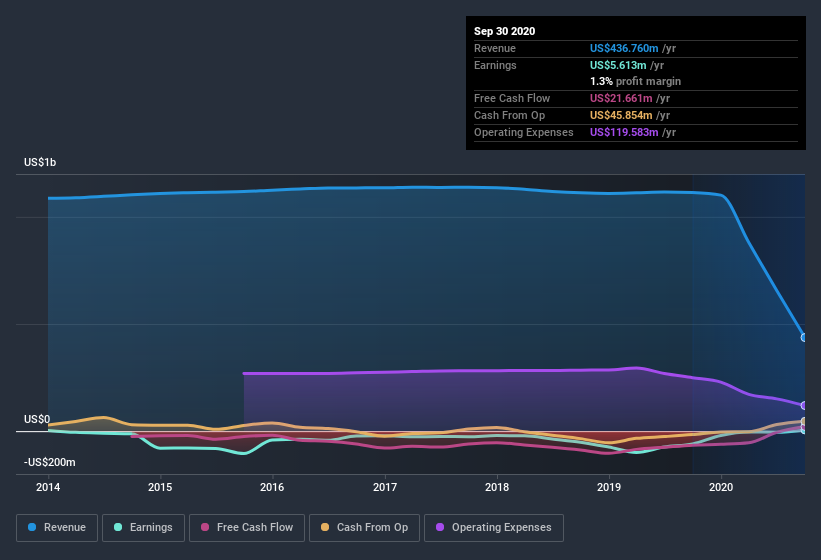- United States
- /
- Healthcare Services
- /
- NasdaqCM:ALR
Are Five Star Senior Living's (NASDAQ:FVE) Statutory Earnings A Good Guide To Its Underlying Profitability?

As a general rule, we think profitable companies are less risky than companies that lose money. That said, the current statutory profit is not always a good guide to a company's underlying profitability. Today we'll focus on whether this year's statutory profits are a good guide to understanding Five Star Senior Living (NASDAQ:FVE).
We like the fact that Five Star Senior Living made a profit of US$5.61m on its revenue of US$436.8m, in the last year. Even though revenue is down over the last three years, you can see in the chart below that the company has moved from loss-making to profitable.
Check out our latest analysis for Five Star Senior Living

Not all profits are equal, and we can learn more about the nature of a company's past profitability by diving deeper into the financial statements. So today we'll look at what Five Star Senior Living's cashflow and unusual items tell us about the quality of its earnings, as well as touching on how its recent share issues are impacting shareholders. That might leave you wondering what analysts are forecasting in terms of future profitability. Luckily, you can click here to see an interactive graph depicting future profitability, based on their estimates.
Examining Cashflow Against Five Star Senior Living's Earnings
Many investors haven't heard of the accrual ratio from cashflow, but it is actually a useful measure of how well a company's profit is backed up by free cash flow (FCF) during a given period. The accrual ratio subtracts the FCF from the profit for a given period, and divides the result by the average operating assets of the company over that time. This ratio tells us how much of a company's profit is not backed by free cashflow.
Therefore, it's actually considered a good thing when a company has a negative accrual ratio, but a bad thing if its accrual ratio is positive. While it's not a problem to have a positive accrual ratio, indicating a certain level of non-cash profits, a high accrual ratio is arguably a bad thing, because it indicates paper profits are not matched by cash flow. To quote a 2014 paper by Lewellen and Resutek, "firms with higher accruals tend to be less profitable in the future".
Over the twelve months to September 2020, Five Star Senior Living recorded an accrual ratio of -0.19. Therefore, its statutory earnings were very significantly less than its free cashflow. To wit, it produced free cash flow of US$22m during the period, dwarfing its reported profit of US$5.61m. Notably, Five Star Senior Living had negative free cash flow last year, so the US$22m it produced this year was a welcome improvement. However, that's not the end of the story. We can look at how unusual items in the profit and loss statement impacted its accrual ratio, as well as explore how dilution is impacting shareholders negatively.
To understand the value of a company's earnings growth, it is imperative to consider any dilution of shareholders' interests. As it happens, Five Star Senior Living issued 521% more new shares over the last year. That means its earnings are split among a greater number of shares. Per share metrics like EPS help us understand how much actual shareholders are benefitting from the company's profits, while the net income level gives us a better view of the company's absolute size. You can see a chart of Five Star Senior Living's EPS by clicking here.
How Is Dilution Impacting Five Star Senior Living's Earnings Per Share? (EPS)
Three years ago, Five Star Senior Living lost money. Zooming in to the last year, we still can't talk about growth rates coherently, since it made a loss last year. What we do know is that while it's great to see a profit over the last twelve months, that profit would have been better, on a per share basis, if the company hadn't needed to issue shares. And so, you can see quite clearly that dilution is having a rather significant impact on shareholders.
In the long term, if Five Star Senior Living's earnings per share can increase, then the share price should too. However, if its profit increases while its earnings per share stay flat (or even fall) then shareholders might not see much benefit. For that reason, you could say that EPS is more important that net income in the long run, assuming the goal is to assess whether a company's share price might grow.
How Do Unusual Items Influence Profit?
Five Star Senior Living's profit was reduced by unusual items worth US$15m in the last twelve months, and this helped it produce high cash conversion, as reflected by its unusual items. In a scenario where those unusual items included non-cash charges, we'd expect to see a strong accrual ratio, which is exactly what has happened in this case. It's never great to see unusual items costing the company profits, but on the upside, things might improve sooner rather than later. When we analysed the vast majority of listed companies worldwide, we found that significant unusual items are often not repeated. And that's hardly a surprise given these line items are considered unusual. Five Star Senior Living took a rather significant hit from unusual items in the year to September 2020. All else being equal, this would likely have the effect of making the statutory profit look worse than its underlying earnings power.
Our Take On Five Star Senior Living's Profit Performance
In conclusion, both Five Star Senior Living's accrual ratio and its unusual items suggest that its statutory earnings are probably reasonably conservative, but the dilution means that per-share performance is weaker than the statutory profit numbers imply. Looking at all these factors, we'd say that Five Star Senior Living's underlying earnings power is at least as good as the statutory numbers would make it seem. So if you'd like to dive deeper into this stock, it's crucial to consider any risks it's facing. For example, Five Star Senior Living has 2 warning signs (and 1 which makes us a bit uncomfortable) we think you should know about.
After our examination into the nature of Five Star Senior Living's profit, we've come away optimistic for the company. But there are plenty of other ways to inform your opinion of a company. Some people consider a high return on equity to be a good sign of a quality business. While it might take a little research on your behalf, you may find this free collection of companies boasting high return on equity, or this list of stocks that insiders are buying to be useful.
When trading Five Star Senior Living or any other investment, use the platform considered by many to be the Professional's Gateway to the Worlds Market, Interactive Brokers. You get the lowest-cost* trading on stocks, options, futures, forex, bonds and funds worldwide from a single integrated account. Promoted
If you're looking to trade AlerisLife, open an account with the lowest-cost platform trusted by professionals, Interactive Brokers.
With clients in over 200 countries and territories, and access to 160 markets, IBKR lets you trade stocks, options, futures, forex, bonds and funds from a single integrated account.
Enjoy no hidden fees, no account minimums, and FX conversion rates as low as 0.03%, far better than what most brokers offer.
Sponsored ContentNew: Manage All Your Stock Portfolios in One Place
We've created the ultimate portfolio companion for stock investors, and it's free.
• Connect an unlimited number of Portfolios and see your total in one currency
• Be alerted to new Warning Signs or Risks via email or mobile
• Track the Fair Value of your stocks
This article by Simply Wall St is general in nature. It does not constitute a recommendation to buy or sell any stock, and does not take account of your objectives, or your financial situation. We aim to bring you long-term focused analysis driven by fundamental data. Note that our analysis may not factor in the latest price-sensitive company announcements or qualitative material. Simply Wall St has no position in any stocks mentioned.
*Interactive Brokers Rated Lowest Cost Broker by StockBrokers.com Annual Online Review 2020
Have feedback on this article? Concerned about the content? Get in touch with us directly. Alternatively, email editorial-team@simplywallst.com.
About NasdaqCM:ALR
AlerisLife
AlerisLife Inc. operates and manages senior living communities in the United States.
Adequate balance sheet and fair value.


